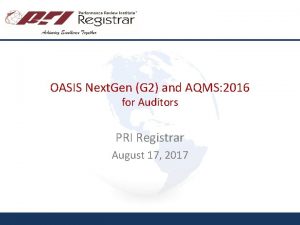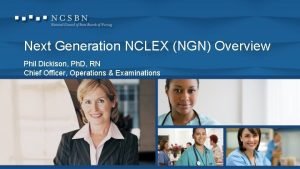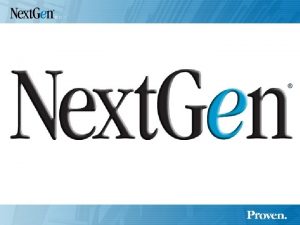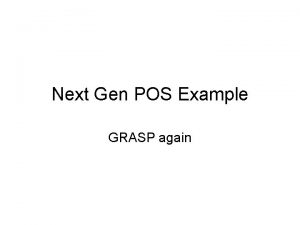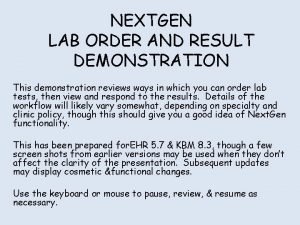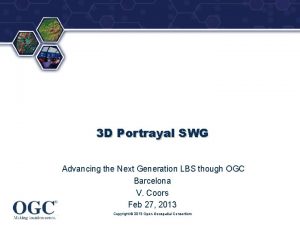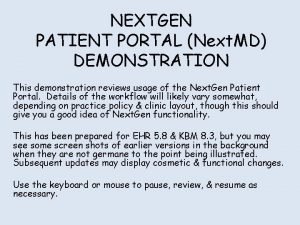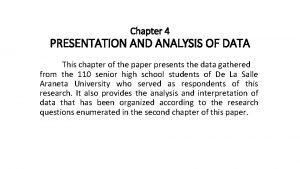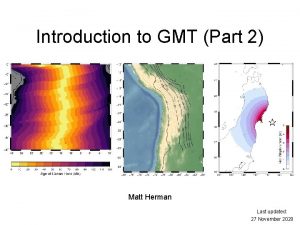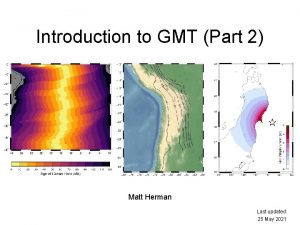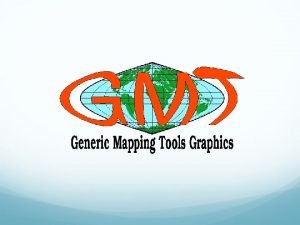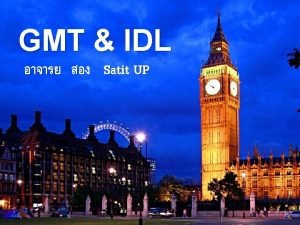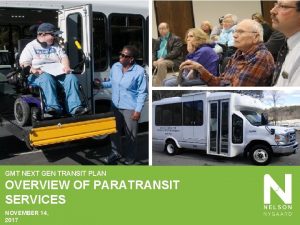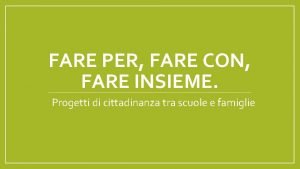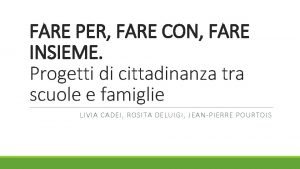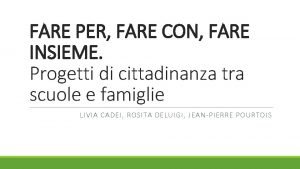GMT NEXT GEN TRANSIT PLAN FARE ANALYSIS FINDINGS




























- Slides: 28

GMT NEXT GEN TRANSIT PLAN FARE ANALYSIS FINDINGS Advisory Committee

GREEN MOUNTAIN TRANSIT PRESENTATION CONTENTS 1. Existing Fare Structure 2. Fare Change Considerations and Methodology 3. Fare Free Considerations 4. Fare Structure Alternatives 5. Ridership and Revenue Impacts 6. Next Steps

EXISTING FARE STRUCTURE

GREEN MOUNTAIN TRANSIT EXISTING GMT FARE STRUCTURE Very inconsistent County Fare Comment Chittenden County Year-Round Local Commuter Free to $1. 25 $2 to $4 Tilley Drive Shuttle and the CSS are free; all others $1. 25 $2 on regular commuter routes and intra-county trips on LINK routes Washington County Year-Round Local Seasonal Commuter Free to $1. 00 Free $1 to $4 Most are free; four are $1. 00 Mad River Valley routes $1 within the same town Lamoille County Year-Round Local Seasonal Commuter $1. 00 Free $1 to $2 FGI Counties Year-Round Local Commuter Free to 50¢ to $4 Morrisville routes Stowe Mountain Road Shuttle $1 within the same town $0. 50 St. Albans Downtown Shuttle, Shopper is free Depending on route and distance traveled Single ride discount fares generally 50% of regular fare 10 -ride tickets generally 9 times the price of single ride fares

GREEN MOUNTAIN TRANSIT EXISTING GMT FARE STRUCTURE Most defining feature is lack of consistency Urban local fares range from free to $1. 25 Rural local fares range from free to $1. 00 Most free, one is 50¢, four are $1. 00 Commuter fares range from 50¢ to $4 Differences based on where you live, the type of commuter service, and distance traveled Fares essentially set by route rather than by route type No clear reason why some riders pay more and some riders pay less Barre to Hospital Hill (via BHH DR) = free Montpelier to Hospital Hill = $1. 00

GREEN MOUNTAIN TRANSIT OTHER VERMONT TRANSIT FARE STRUCTURES GMT fares in the middle range of Vermont Transit Providers Provider Local Service Commuter Advance Transit Free Rural Community Transportation (RCT) Free Southeast Vermont Transit Free - $1. 00 - $2. 00 GMT Free - $1. 25 50¢ to $4. 00 Addison County Transit Resources (ACTR) Free - $2. 00 $4. 00 Marble Valley Regional Transit (The Ride) 50¢ - $2. 00 Stagecoach Transportation Services Free - $2. 00 Free - $3. 50

FARE CHANGE METHODOLOGY

GREEN MOUNTAIN TRANSIT FARE ANALYSIS METHODOLOGY Ridership impacts based on observed impacts at other transit systems Used elasticities for changes with before and after fares that are greater than free Used percentage increases and decreases in cases where fares are either now free or would be free Fare change elasticities: A measure that relates percentage changes in fares to percentage changes in ridership For example, and elasticity of -0. 20 means that a 1% increase in fares would produce a 0. 2% decrease in ridership

GREEN MOUNTAIN TRANSIT FARE ANALYSIS METHODOLOGY Percent increases and decreases based on changes in adult cash fare Percent changes in discount fares are slightly different but not meaningfull Revenue estimates based on average fares To include impacts of discount fares For example, if one passenger pays a full fare of $1 and another pays a discount fare of 50¢, average fare is 75¢ Estimates of changes in total revenue based on Changes in average fares Increase or decrease in ridership All changes determined on a route-by-route basis

GREEN MOUNTAIN TRANSIT FARE MODEL ELASTICITIES Developed a range of estimates: Model A: Uses a single elasticity that reflects overall impacts in service areas of less than 1 million residents Model B: Uses elasticities for different service types but that do not consider service area size [Note: Elasticities by service types for small urban areas not available] Provider Model A Model B Urban Local -0. 43 -0. 40 Rural Local -0. 43 -0. 50 Shuttle -0. 43 -0. 48 Commuter -0. 27 Express Commuter (LINK) -0. 30 Source: (www. apta. com/resources/reportsandpublications/Documents/Pham_Linsalata_Fare_Elasticity_1991. pdf)

FARE FREE CONSIDERATIONS

GREEN MOUNTAIN TRANSIT FARE-FREE CONSIDERATIONS: WHERE OFFERED

GREEN MOUNTAIN TRANSIT FARE FREE CONSIDERATIONS: MARKET TYPES Existing fare free systems serve small/low ridership markets and/or specialty markets Does GMT Serve this Type of Market? Does GMT Offer Fare Free Service? No – Burlington area ridership more than modest No Large Rural Areas with Low Ridership Yes No Resort Communities Yes University-Dominated Communities No – Burlington has multiple universities, but student ridership does not dominate NA Type of Market Small Urban Areas with Modest Ridership

GREEN MOUNTAIN TRANSIT WHAT ARE THE LARGEST FARE-FREE SYSTEMS? All are small GMT would be largest fare free system in US Transit System Go. Line Hele-on Bus (free until 2011; now $2. 00) North Central RTD (except two “premium” routes) Green Mountain Transit Location Service Area Population Number of Routes Annual Ridership Indian County, FL 174, 000 14 850, 000 Hawaii County, HI 174, 000 15 1. 3 million Taos, NM 218, 000 27 112. 000 VT 296, 000 50 2. 5 million

GREEN MOUNTAIN TRANSIT HOW MUCH HAS RIDERSHIP INCREASED? Small urban and rural systems: 32% (Lebanon, NH) to 205% (Hawaii County) University towns: 21% (Boone, NC) to 43% (Chapel Hill, NC & Corvallis, OR) Free fare experiments: 13% (SLC) to 86% (Topeka) Typical: 20% to 60% increase

GREEN MOUNTAIN TRANSIT WHAT ARE THE COSTS? Loss of fare revenue Reductions in costs Cost of collecting fares Most common reason for not charging fares is that low ridership makes fare collection not cost-effective Increases in costs Cost to provide more service on routes that are now at or near capacity Costs to purchase additional buses to provide more service (These costs would be minimal for GMT)

FARE STRUCTURE ALTERNATIVES

GREEN MOUNTAIN TRANSIT FARE STRUCTURE ALTERNATIVES Alternatives developed by Advisory Committee: Urban Local Rural Local Seasonal LINK Other Commuter Free to $1. 25 Free to $1. 00 Free $2. 00 - $4. 00 50¢ to $2. 00 Alternative A $1. 00 Free $3. 00 $2. 00 Alternative B $1. 25 Free No change $2. 00 Alternative C $1. 50 $1. 00 Free No change $2. 00 Alternative D 50¢ Free No change $1. 00 Alternative E Free Free Existing

RIDERSHIP AND REVENUE IMPACTS

GREEN MOUNTAIN TRANSIT ALTERNATIVE A: RIDERSHIP & REVENUE IMPACTS Major fare changes: Reduce Urban Local to $1 and LINK fares to $3 Ridership impact: +3 to 5% Annual revenue impact: -$255, 000 $1. 00 Urban Local $1. 00 Rural Local Free Tourism $2. 00 Commuter $3. 00 LINK Total Chittenden County Ridership Change Revenue Change +4 to 7% -5 to -8% --- +4 to 6% -9 to -10% +4 to 7% -5 to -8% Washington County Ridership Change Revenue Change --- -11 to -13% +75 to 81% +8 to 11% -23 to -26% Lamoille County Ridership Change Revenue Change --- -2% 96% 0% 0% FGI Counties Ridership Change Revenue Change --- -19 to -26% +49 to 63% -4 to -5% -31 to -81% Total Ridership Change Revenue Change +4 to 7% -5 to -8% -9 to -11% +72 to 79% +4. 7 to 7% -24% to -29% -2 to -3% -15 to -17% -2% -18% -9 to -12% -29 to -71% +3 to 5% -11%

GREEN MOUNTAIN TRANSIT ALTERNATIVE B: RIDERSHIP AND REVENUE IMPACTS Major fare changes: Fare-free on rural and seasonal routes Ridership impact: -1. 1 to -1. 2%; Annual revenue impact: $9, 000 to $16, 000 $1. 25 Urban Local Free Rural Local Free Tourism $2. 00 Commuter $4. 00 LINK Total Chittenden County Ridership Change Revenue Change -2% 7% --- 0% 0% -2% +6% Washington County Ridership Change Revenue Change --- +5 to 6% -28 to -34% 0% -12% Lamoille County Ridership Change Revenue Change --- +2% -100% 0% 0% FGI Counties Ridership Change Revenue Change --- +20% -100% -7 to -10% -16 to -20% Total Ridership Change Revenue Change -2% 7% +5 to 6% -42 to -47% -1. 2 to -1. 6% -10 to -11% +3% -13 to -14% +2% -19% +2 to 0% -15 to -19% -1. 1 to -1. 2% +0. 4 to 0. 7% 6

GREEN MOUNTAIN TRANSIT ALTERNATIVE C: RIDERSHIP & REVENUE IMPACTS Major fare changes: Urban Local fare to $1. 50 and all Rural routes at $1. 00 Ridership impact: -7 to -9%; Annual revenue impact: $235, 000 to $280, 000 $1. 50 Urban Local $1. 00 Rural Local Free Tourism $2. 00 Commuter $4. 00 LINK Total Chittenden County Ridership Change Revenue Change -7 to -9% 18 to 21% --- 0% 0% -7 to -9% +17 to 19% Washington County Ridership Change Revenue Change --- -11 to -13% +75 to 84% 0% -12% Lamoille County Ridership Change Revenue Change --- -2% +96% 0% 0% FGI Counties Ridership Change Revenue Change --- -19 to -26% +49 to 63% -7 to -10% -19 to -20% Total Ridership Change Revenue Change -7 to -9% 18 to 21% -10 to -11% +72 to 79% -1. 2 to -1. 6% -11% -6 to -7% -4 to -5% -2% +18% -11 to -15% -18 to -19% -7 to -9% +10 to 12%

GREEN MOUNTAIN TRANSIT ALTERNATIVE D: RIDERSHIP & REVENUE IMPACTS Major fare changes: $0. 50 Urban Local and Rural route fare, and $1 Commuter fare Ridership impact: +22 to 34% Annual revenue impact: -$619, 000 to -$733, 000 $0. 50 Urban Local $0. 50 Rural Local Free Tourism $1. 00 Commuter $4. 00 LINK Total Chittenden County Ridership Change Revenue Change +27 to 42% -34 to -41% --- +13 to 20% -14 to -16% +27 to 42% -32 to -39% Washington County Ridership Change Revenue Change --- -2 to 0% +32 to 36% +4 to 6% -14% Lamoille County Ridership Change Revenue Change --- -1 to 0% +57 to 63% +23 to 35% -33 to -38% FGI Counties Ridership Change Revenue Change --- 0% 0% +6 to 9% -16 to -19% Total Ridership Change Revenue Change +27 to 42% -34 to -41% -2 to 0% +29 to 32% +7 to 10% -23 to -25% 0 to 3% -10% +3 to 5% -15 to -21% +4 to 6% -15 to -18% +22 to 34% -26 to -31%

GREEN MOUNTAIN TRANSIT ALTERNATIVE E: FARE FREE RIDERSHIP INCREASES 88% of ridership increases would be in Chittenden County Free Urban Local Free Rural Local Free Link/ Commuter Total Chittenden County Increase % Increase +837, 300 +40% --- +19, 737 +49% +856, 323 +40% Washington County Increase % Increase --- +18, 219 +12% +70, 448 +37% +88, 667 +25% Lamoille County Current Projected --- +1, 938 +2% +4, 896 +40% +6, 834 +8% FGI Counties Current Projected --- +4, 129 +20% +20, 604 +48% +24, 733 +39% Total Current Projected +837, 300 +40% +24, 285 +10% +115, 685 +40% +977, 271 +37% Note: Figures represent annual ridership; assumes 60% increase on routes with $4 fares, 40% increase on routes with fares of $1 to $2, and 20% on routes with 50¢ fare.

GREEN MOUNTAIN TRANSIT ALTERNATIVE E: RIDERSHIP & REVENUE IMPACTS Fare changes: Fare-free Ridership impact: +37% Annual revenue impact: -$2, 364, 000 Free Urban Local Free Rural Local Free Tourism Free Commuter Free LINK Total Chittenden County Ridership Change Revenue Change +40% -100% --- +48% -100% +40% -100% Washington County Ridership Change Revenue Change --- +17% -100% +36% -100% Lamoille County Ridership Change Revenue Change --- +2% -100% +40% -100% FGI Counties Ridership Change Revenue Change --- +20% -100% +48% -100% Total Ridership Change Revenue Change +40% -100% +13% -100% +40% -100% +25% -100% +8% -100% +39% -100% +37% -100%

GREEN MOUNTAIN TRANSIT SUMMARY Ridership: Highest increases with Alternative E (fare free) Revenue: Lowest reduction with Alternative B (free Rural Local) Alternative A Alternative C Alternative D ($1 Urban Local; $3 LINK) (Rural Local free) ($1. 50 Urban Local; $1 Rural Local (all)) (50¢ Urban & Rural Local; $1 Commuter) +4 to 7% -5 to -8% -2% +6% -7 to -9% +17 to 19% +27 to 42% -32 to -39% +40% -100% Washington County Ridership Change Revenue Change -2 to -3% -15 to -17% +3% -13 to -14% -6 to -7% -4 to -5% 0 to 3% -10% +25% -100% Lamoille County Ridership Change Revenue Change -2% -18% +2% -19% -2% +18% +3 to 5% -15 to -21% +8% -100% FGI Counties Ridership Change Revenue Change -9 to -12% -29 to -71% +2 to 0% -15 to -19% -11 to -15% -18 to -19% +4 to 6% -15 to -18% +39% -100% +3 to 5% -11% -1. 1 to -1. 2% +0. 4 to 0. 7% -7 to -9% +10 to 12% +22 to 34% -26 to -31% +37% -100% Chittenden County Ridership Change Revenue Change Total Ridership Change Revenue Change Alternative B Alternative E (Fare-Free)

NEXT STEPS

GREEN MOUNTAIN TRANSIT ADDRESS FARE CHANGE CONSIDERATIONS What are priorities? Reduce fares Improve service How much fare revenue is needed to provide desired service? If fares are reduced, can other revenue sources be found? How important is consistency? How many exceptions should be made and why? Should riders in different areas pay different fares? (Near universal practice is to set fares based on service type and to charge same fares in all areas) These are all policy questions that have not yet been addressed
 Analyze
Analyze X.next = x.next.next
X.next = x.next.next Next-generation digital services
Next-generation digital services Oasis next gen
Oasis next gen E-hrms
E-hrms Ncsbn clinical judgement model
Ncsbn clinical judgement model Cloze items nclex
Cloze items nclex Nextgenu
Nextgenu Next gen emr
Next gen emr Next gen pos
Next gen pos Next gen consulting
Next gen consulting Nextgen ehr tips and tricks
Nextgen ehr tips and tricks Next generation learning standards nys
Next generation learning standards nys Nys next generation math standards
Nys next generation math standards Next gen swg
Next gen swg Next gen eu
Next gen eu Glsl outline
Glsl outline Nextgen tasking workflow
Nextgen tasking workflow Next gen flowers
Next gen flowers Chapter 4 research data analysis
Chapter 4 research data analysis Data analysis in research sample
Data analysis in research sample Gmt surface
Gmt surface Makecpt gmt
Makecpt gmt Single bevel instrument
Single bevel instrument Generic mapping tools
Generic mapping tools 180° longitude
180° longitude Psscale
Psscale Gmt
Gmt What is gmt
What is gmt



